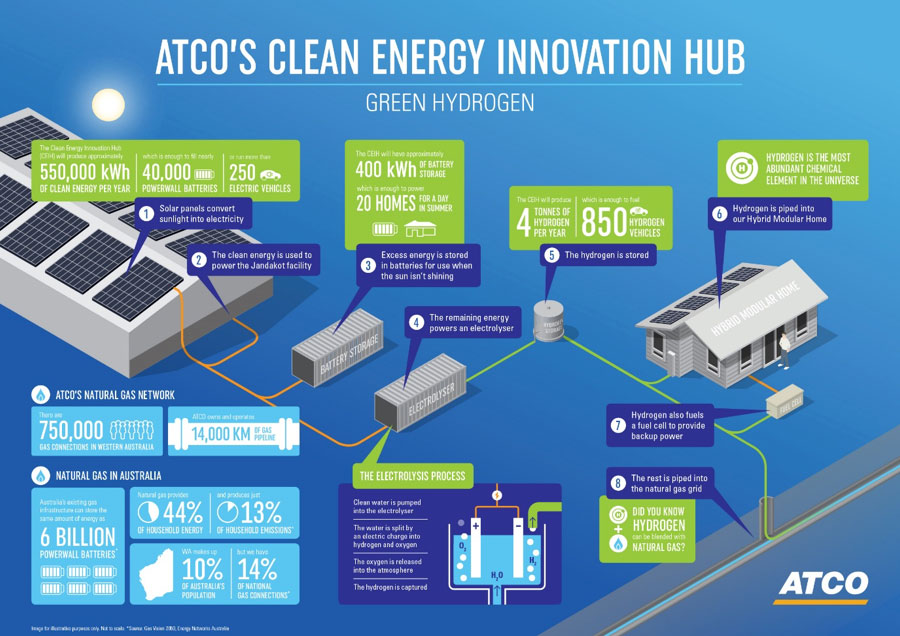Canadian-owned gas network operator ATCO’s $3.6 million (US$2.53 million) Clean Energy Innovation Hub tasked with investigating the potential role of hydrogen in the future energy mix was officially unveiled in Jandakot on Thursday. On the same day, the Western Australian (WA) government has launched a strategy to set course for the state’s renewable hydrogen future.
ATCO’s facility features a microgrid with around 1,100 solar panels, each capable of generating 300 kW of power, and 400 kWh of battery storage capacity. With the PV system capable of producing two-and-a-half times the daily power requirements of the facility, excess solar energy is partially stored in batteries while the rest is used to power an electrolyzer and produce hydrogen. Hydrogen is then stored as fuel for a back-up generator or blended with natural gas.
In addition to testing the use of hydrogen in different settings and applications including in household appliances, the Jandakot hub will provide insights into optimizing hydrogen storage and distribution solutions, blending hydrogen with natural gas and using hydrogen as a balancing fuel to support the grid. The project was underpinned by $1.5 million in funding from the Australian Renewable Energy Agency (ARENA).
“It is very encouraging to see industry investing in new technologies and aiding research for a cleaner, greener energy future in Western Australia,” energy minister Bill Johnston said. “The McGowan government is moving forward with reforms to modernize the structure and design of Western Australia’s energy market to deliver cleaner and more affordable energy to all consumers.”
Popular content
In the latest such move, the WA government has launched its Renewable Hydrogen Strategy seeking to position the state as a major producer and exporter of renewable hydrogen. To support projects on the ground, the government has established a $10 million Renewable Hydrogen Fund to facilitate private sector investment in the renewable hydrogen industry.
With its vast renewable energy sources including solar and wind, extensive land mass, a strong existing energy export sector and proximity to Asia, WA is well-positioned to tap key hydrogen markets such as Japan and Korea. The government’s strategy sets four strategic focus areas: export, applications in remotely located industries, hydrogen blending in natural gas networks, and transport using fuel cell electric vehicles.
“This [hydrogen] is a major opportunity for WA, however it will not occur without significant investment and lead times: this strategy and our Renewable Hydrogen Fund are the first steps down that path,” said Regional Development Minister Alannah MacTiernan. “We need to build our domestic hydrogen market and our skills base, to drive the transition for our existing industries and capitalise on this opportunity for WA’s economy, supporting regional jobs and growth.”
WA’s strategy follows the launch of a similar document in Queensland. Under its $19 million hydrogen strategy, the state government has made funding available for a pipeline of new hydrogen projects across the state. Meanwhile, the federal government’s national hydrogen strategy has edged closer with the release of consultation papers.
This content is protected by copyright and may not be reused. If you want to cooperate with us and would like to reuse some of our content, please contact: editors@pv-magazine.com.



“announced the creation of a $10 green hydrogen fund.”
I’m happy to chip in and double that.
That’s very generous of you Martyn. Sadly, the subheader has now been amended to reflect it’s actually a $10 million fund, but I’m sure all contributions would be gratefully received!